
The longhorn beetles (Cerambycidae), also known as long-horned or longicorns, are a large family of beetles, with over 26,000 species described, slightly more than half from the Eastern Hemisphere. Most species are characterized by extremely long antennae, which are often as long as or longer than the beetle's body. In various members of the family, however, the antennae are quite short and such species can be difficult to distinguish from related beetle families such as the Chrysomelidae. The scientific name of this beetle family goes back to a figure from Greek mythology: after an argument with nymphs, the shepherd Cerambus was transformed into a large beetle with horns.

The Fulcidacini are a tribe within the leaf beetle subfamily Cryptocephalinae, though historically they were often treated as a distinct subfamily, Chlamisinae. 11 genera with altogether about 400 species are currently placed here; some four-fifths of the species are found in the Neotropics, but the rest is distributed over all other continents except Antarctica.

Lamiinae, commonly called flat-faced longhorns, are a subfamily of the longhorn beetle family (Cerambycidae). The subfamily includes over 750 genera, rivaled in diversity within the family only by the subfamily Cerambycinae.
Friedrich F. Tippmann was a Hungarian entomologist who specialised in Coleoptera, especially the Cerambycidae.

Johannes Eusebius Voet was a Dutch physician, poet, illustrator, and entomologist. Johannes was the son of Carel Burchat Voet (1671-1745) who was court-painter to the Earl of Portland and also an entomologist.

Otiorhynchus is a large genus of weevils in the family Curculionidae. Many species of the genus, particularly the black vine weevil and the strawberry root weevil, are important pests, both as larvae and as adults. Larvae feed on plant roots. Adults are flightless with fused elytra and feed at night on plant foliage. In many species of the genus at least some races are polyploid and parthenogenetic, while the rest of the races and species are diploid and bisexual. Otiorhynchus weevils, particularly O. scaber, have been a popular subject for studies of the evolution of parthenogenesis. The genus is native to the Palearctic region. However, sixteen species were inadvertently introduced to North America and have become widespread there.
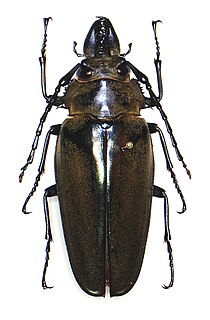
The Trictenotomidae are a small family of beetles in the suborder Polyphaga containing fifteen species in two genera. Most species are found in the Oriental realm where they live in montane forest habitats. The family is considered, based on larval characters as well as sequence-based studies, to be closely related to the Salpingidae.
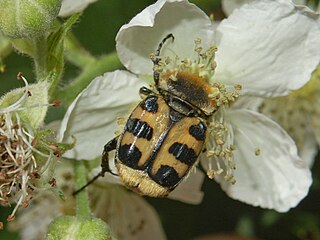
Trichius gallicus is a beetle species belonging to the family Scarabaeidae, subfamily Cetoniinae. It frequently appears in the literature under the name "Trichius rosaceus", but this name is permanently unavailable under ICZN Article 11.4, as are all of Voet's names.

Leiopus nebulosus is a species of longhorn beetle of the subfamily Lamiinae. It was described by Carl Linnaeus in his landmark 1758 10th edition of Systema Naturae. It contains two subspecies; the first, L. nebulosus nebulosus, is known from Europe and Russia, and the second, L. nebulosus caucasicus, is endemic to the mountains of the Caucasus. The beetles inhabit deciduous trees, including those in the genera Fagus, Quercus, Carpinus, Juglans, Acer, Ulmus, Betula, Salix, and Prunus. They measure 5–10 millimetres in length, and can live for approximately 1–2 years.

Batus barbicornis is a species of beetle in the family Cerambycidae. It was described by Carl Linnaeus in 1764.
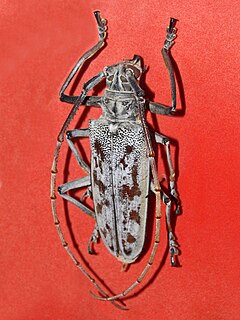
Batocera maculata is a species of flat-faced longhorn beetle in the subfamily Lamiinae of the family Cerambycidae. While originally named as "Lamia tigris" by Voet in 1778, no name was validly published for this species until 1817; Voet's 1778 work fails to fulfill the requirement in ICZN Article 11.4 that a work must be consistently binominal, and all names within that work are unavailable.
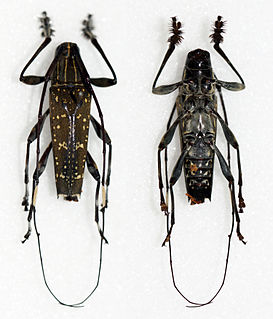
Colobothea is a genus of longhorn beetles of the subfamily Lamiinae.

Aristobia approximator is a species of beetle in the Longhorn family. This species grows to 36mm.

Hemierana is a genus of beetle in the family Cerambycidae, from North America. It contains two described species:
Eupalessa attenuata is a species of beetle in the family Cerambycidae, and the only species in the genus Eupalessa. It was described by James Thomson in 1868. The genus was originally known as Eupales, named by Dillon and Dillon in 1946; however, this name was preoccupied by the leaf beetle genus EupalesLefèvre, 1885, so it was renamed to Eupalessa by Miguel A. Monné in 2005.
Batocera armata is a species of flat-faced longhorn beetle in the subfamily Lamiinae of the family Cerambycidae. While originally named as "Cerambyx thomae" by Voet in 1778, no name was validly published for this species until 1800; Voet's 1778 work fails to fulfill the requirement in ICZN Article 11.4 that a work must be consistently binominal, and all names within that work are unavailable.
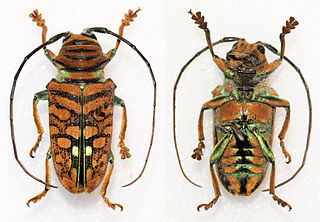
Sternotomis chrysopras is a species of beetle in the family Cerambycidae. It has a wide distribution in Africa. It feeds on Artocarpus altilis, Theobroma cacao, Coffea liberica, and Coffea canephora. While originally named by Voet in 1778, the name was not validly published until 1844; Voet's 1778 work fails to fulfill the requirement in ICZN Article 11.4 that a work must be consistently binominal; none of Voet's 1778 names, including S. chrysopras, are available.

Cypherotylus is a genus of pleasing fungus beetles in the family Erotylidae. There are over 30 described species in Cypherotylus. It frequently appears in the literature under the name "Gibbifer", but this name is permanently unavailable under ICZN Article 11.4, as are all of Voet's names.

Euryphagus is a genus of longhorn beetles native to tropical Asia. It is classified in the family Cerambycidae, subfamily Cerambycinae, and the tribe Trachyderini. The generic name is derived from Greek εὐρύς and φαγεῖν referring to the broad mandibles of the males.

The lemon tree borer, also known as the whistling beetle or the singing beetle, is a longhorn beetle endemic to New Zealand. Its larvae are generalist feeders, boring into the wood of a wide variety of trees, native and introduced. When citrus orchards were first established in New Zealand, this beetle started inflicting serious damage, and so gained the name "lemon tree borer". Four species within the genus Oemona have been identified, suggesting that more species could be found. When disturbed by predators or humans, the adult beetle stridulates creating a "rasp" or "squeak" sound by rubbing its thorax and head together against an area of thin ridges. Māori would eat a liquid called "pia manuka", which was produced by manuka trees when its wood was damaged by the larva. When Captain Cook first arrived in NZ, his naturalists, Banks and Solander, collected a lemon tree borer in their first collection between 1769-1771. This oldest collected specimen can be found in the British Museum. A few years after the first collection, the species would be first described by the Danish naturalist Fabricius in 1775.
















